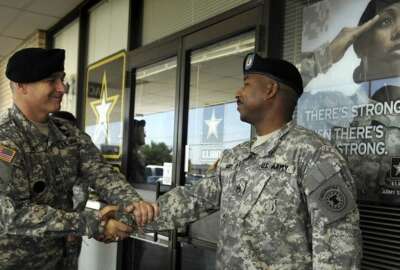Hubbard Radio Washington DC, LLC. All rights reserved. This website is not intended for users located within the European Economic Area.
Army recruitment seeks civilian employees
The Army relies on its civilian workforce for crucial tasks to support readiness and operations. Now it has launched a campaign to recruit civilians.
The Army relies on its civilian workforce for a myriad of crucial tasks to support readiness and operations. Now it has launched a first-ever campaign to recruit civilians into the Army. For more on the Find Your Next Level program, the Federal Drive with Tom Temin talked with the Army’s chief marketing officer, Brig. Gen. Antoinette Gant.
Interview Transcript:
Antoinette Gant A lot of this is about awareness, you know, as we think about the U.S. Army, most people think about those that are serving in uniform. But what they don’t know is that we have over 260,000 civilians that are actually working alongside those soldiers in regard to ensuring that we can continue to be successful in our mission.
Tom Temin Give us some more numbers. I mean, you mentioned a big number of civilians. What do they generally do and how does the workforce break down in broad terms?
Antoinette Gant Yeah. So, you have civilians that are doing a number of different jobs. We have what’s called a government system, a GPS system. So, you can go from a GS of five or even a two, which is a student intern, all the way to a GS 15. So, there are different levels. There are different types of jobs. More importantly for this campaign, we are really highlighting some of our STEM, our science, technology, engineering and math, positions that we actually have. We found that that as well as Logisticians are kind of the top jobs that we’re looking for right now, across the Army in a variety of different locations of which they can serve.
Tom Temin So science and technology and math, this would be mostly in the research function.
Antoinette Gant It’s a little bit of everything. I’ll give you a really good example. So, prior to this job, I was with the Army Corps of Engineers and internal to the Army Corps of Engineers. We actually have engineers of all types, electrical engineers, civil engineers. We also have scientists, biologists. Some people don’t even realize that we have interior designers. So that’s still within, form of a, you know, a technical field of which we, support. But it is a variety of, of jobs in those positions. So not necessarily just on research, but research is very important to us as well.
Tom Temin By the way, what interiors do they design out of curiosity?
Antoinette Gant That is, you know, any real estate, or design of a building that we’re doing. They are responsible for actually doing the layout for those buildings. Another good example would be our DoDea schools. They’re not designing just here in the United States, but also in areas of Japan. And, then the islands, wherever there’s a DoDea school they’re designing what that school actually looks like. The economics of the actual, the chairs and things of that nature that the, the students will be in, in those particular locations. How do you actually look at in designing a location where it can serve dual purposes, a lunchroom as well as an auditorium? So, there are just so many different things that they bring to the table that to have your own internal interior design is a pretty, pretty neat.
Tom Temin And just a brief question on the logistics side, because, of course, you know, the professionals in the Army talk about logistics. That’s the old saying and not about battle strategy. What do Logisticians do? That’s a lot of functions that need logistics.
Antoinette Gant Absolutely. If it’s getting, supplies from one location to another, if it’s actually making sure that, we have the right supplies in the right locations. I mean, logisticians, from a data analysis standpoint, they’re looking to make sure we have the right amount of what we actually need. So, there are just a number of different things that our logisticians actually bring to bear, especially in the transportation standpoint.
Tom Temin Therefore, agencies like the Army Materiel Command could be a place where they would go.
Antoinette Gant This is our transportation hub at it’s got Air Force Base and that’s another location. Installation, command. Those are various locations DEFCOM I mean, I can go on and on in naming the various agencies internal to the Army or commands that utilize Logisticians as well as some of our STEM careers.
Tom Temin We’re speaking with Brigadier General Antoinette Gant. She’s chief marketing officer of the army. Let’s get to this program you have for recruitment here for civilians. Again, it’s called the Find Your Next Level program. What form does it take and how are you going about getting the message out to people that might want to work for the Army?
Antoinette Gant The fact that this is the first campaign for Army civilians that the Army is actually have, I think, is an enormous step of actually identifying that how important our army civilians are and what we actually do. And so, we’re getting the word out in a number of ways. On Netflix is a one of the locations of which you will see some of our Army ads. Mainly this is in the streaming area. You won’t see it on linear television just yet, but in various different forms from a streaming standpoint.
Tom Temin So Netflix and other media where you think people might be watching.
Antoinette Gant And most folks now these days are actually doing a lot of streaming versus watching linear television. So, we’re trying to be in those spaces. As a matter of fact, LinkedIn, you can actually if you go to our go army.com website or even our Army civilian career.com website, you can be able to talk to you about the various career, opportunities. I think right now we have about 3800 job openings listed. And this just continues to it’s very fluid. It doesn’t stay. It might be 3800 today and tomorrow it might be 3820. So, it just depends on what the what we’re actually looking for.
Tom Temin And do you have means that you can use to target people say through LinkedIn, there’s millions of people on some of these platforms and get an ad in that will go to people that might be ripe for this, depending on their characteristics, in their profile.
Antoinette Gant And most influential way to be able to do that is on our army civilian career.com because there would give you a link where you can actually it’ll explain to you what you need to do as far as inputting your resume. USAjobs.com is the other area of which you can go to. I wanted to bring up a point of the fact that we have just also launched what’s called the Total Army Career Fair, and we did our first one in Arlington, Texas, and it just happened in a couple of weeks ago in April. And we’ll be doing another one the 13th and 14th of September. And this is an opportunity to be at and this will be in Houston. But it’s an opportunity to be at a large location where we know there are a number of people, entry level, as well as middle management that are looking for either a career change or just a new, entry level position. And there they can be able to talk to individuals on the spot about career opportunities that the Army actually has. I think this is this is the second time we will be doing this and what a great opportunity it is, especially in some of our large metropolitan areas.
Tom Temin And he plans to do campus recruitment.
Antoinette Gant Campus recruitment goes on all the time. And a lot of that is actually done with various organizations. I mentioned the Army Corps of Engineers, but they are Army Materiel Command also is another one where they look at the career fairs that are happening on the college campuses, and they are, attending those, to ensure that they are getting the best and the brightest, especially looking at a army with, I mean, a career with someone like the Army, where I always say you can do things that you never thought were possible.
Tom Temin And are. Is the Army able to speed up the civilian hiring process so that you’re faster than the average federal job.
Antoinette Gant And on average, it takes about 90 days? It depends. If there’s something that has to do with security clearances and things of that nature. But we have this thing that’s called direct hiring authority, which allows our, the, the various organizations that are at these job fairs to be able to hire individuals or give them a tentative job offer on the spot. So, with that, that definitely is a win for us. And being able to know that, hey, we are wanting you to come and join our team.
Tom Temin And what about the veterans preference? Because that is in place for every federal agency, particularly military and veterans affairs, where there’s a large percentage of the workforce that is veterans.
Antoinette Gant Absolutely. And we do have the Veterans Preference Program. Of course, there are policy and laws that apply with that, and we utilize them, in all that we do.
Tom Temin All right. And just a final question. I wanted to get at that social media outreach idea because people receive ads on social media platforms based on their profiles and the algorithms. I see, the ads I get, and they know me pretty well. Are you able to tap into that ecosystem? Can the government fairly do that?
Antoinette Gant The ads that I get, I know I’m getting them because of the things that I’m looking at. So, we are definitely looking at it from, a I guess it’s an algorithm that actually happens, depending on what it is that they’re looking at, to make that determination of, hey, this could be a potential place for you to.
Tom Temin Be because that’s where marketing is going nowadays. Right? As opposed.
Antoinette Gant To. Absolutely. You know, you don’t want to know how many ads we I mean, I’m sure you think about something and all of a sudden an ad actually shows up, right?
Tom Temin Yes. It’s a little spooky sometimes, but, you know, the Army used to have a spot, you know, with a song, you know, on the Carol Burnett Show or something. Those days are long gone.
Antoinette Gant This is about, again, looking to ensure that we find the best and the brightest. And again, as I said, so those individuals, whether they are just newly forming, coming out of college, looking for a job or those that are just looking. What? Career change? The Army is a place that we have a diverse population of individuals. To be able to come and actually work as a civilian with us.
Copyright © 2024 Federal News Network. All rights reserved. This website is not intended for users located within the European Economic Area.
Tom Temin
Tom Temin is host of the Federal Drive and has been providing insight on federal technology and management issues for more than 30 years.
Follow @tteminWFED





